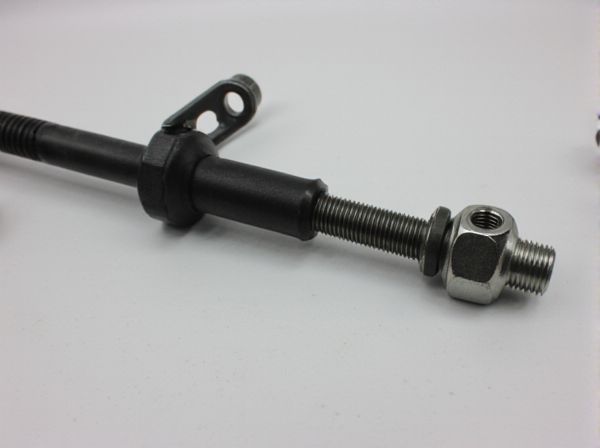
Photo illustration: Ball Nut Steering vs Cam-and-Lever Steering
Ball nut steering offers smoother, more precise control by reducing friction through its rolling ball mechanism, enhancing your vehicle's responsiveness compared to the traditional cam-and-lever steering. Cam-and-lever steering relies on a direct mechanical linkage that can produce more play and less accuracy, especially under heavy loads or wear. Choosing ball nut steering improves durability and steering feel, making it ideal for modern vehicles requiring tight handling performance.
Table of Comparison
| Feature | Ball Nut Steering | Cam-and-Lever Steering |
|---|---|---|
| Mechanism Type | Ball screw and nut assembly | Cam lever and sector gear |
| Steering Precision | High accuracy and smooth operation | Moderate accuracy with some play |
| Durability | Long lifespan; resistant to wear | Less durable; prone to wear over time |
| Maintenance | Low maintenance; requires occasional lubrication | Higher maintenance; frequent adjustments needed |
| Application | Heavy-duty trucks and commercial vehicles | Light vehicles and older car models |
| Cost | Higher manufacturing and repair cost | Lower initial cost and simpler design |
| Steering Feedback | Consistent and direct feedback | Less consistent; can feel vague |
Introduction to Steering Mechanisms
Ball nut steering systems use a recirculating ball mechanism to convert rotational motion into linear motion with minimal friction, enhancing steering precision and durability. Cam-and-lever steering relies on a cam rotation acting on a lever, offering simpler construction but higher wear and less accuracy over time. The ball nut design is preferred in modern vehicles for its efficiency and longevity, while cam-and-lever systems remain common in older or lighter machinery.
Overview of Ball Nut Steering
Ball nut steering systems utilize a recirculating ball mechanism to convert rotational motion of the steering wheel into linear motion, providing precise and efficient directional control. This design reduces friction and wear, ensuring smoother steering response and increased durability compared to traditional cam-and-lever systems. Commonly used in older vehicles and heavy-duty applications, ball nut steering offers enhanced mechanical advantage and improved feedback for drivers.
Overview of Cam-and-Lever Steering
Cam-and-lever steering utilizes a cam attached to the steering shaft that moves a lever linked to the steering linkage, translating rotational motion into linear motion to control the wheels. This steering mechanism is simpler and typically found in older or smaller vehicles, offering reliable performance with fewer components. Compared to ball nut steering, cam-and-lever systems tend to have more play and less precision but remain cost-effective for basic steering applications.
Key Components Comparison
Ball nut steering features a recirculating ball mechanism where ball bearings reduce friction between the worm gear and the nut, enhancing durability and precision. In contrast, cam-and-lever steering utilizes a cam that presses against a lever arm to convert rotary motion into linear motion, with fewer moving components but increased wear potential. Key components of ball nut steering include the worm shaft, ball bearings, and nut assembly, while cam-and-lever steering relies primarily on the cam, lever arm, and sector gear for operation.
How Ball Nut Steering Works
Ball nut steering operates by converting the rotational motion of the steering wheel into linear motion through a ball screw mechanism, where steel balls circulate between the screw and the nut to reduce friction and wear. This design ensures precise and smooth steering control by minimizing backlash and distributing load evenly along the threads. The efficiency of ball nut steering makes it preferable in modern vehicles demanding higher steering accuracy and durability compared to the simpler cam-and-lever steering system.
How Cam-and-Lever Steering Works
Cam-and-lever steering operates through a cam attached to the steering shaft that engages with a lever arm connected to the steering linkage, converting rotary motion into linear motion to steer vehicle wheels. The cam's eccentric shape pushes the lever in a precise path, allowing controlled direction changes with minimal play and direct feedback. This mechanism contrasts with ball nut steering, which uses recirculating ball bearings for smoother, low-friction operation.
Performance and Precision Differences
Ball nut steering systems offer superior performance and precision due to reduced friction and smoother operation, enabling more accurate control in modern vehicles. Cam-and-lever steering mechanisms, while simpler and cost-effective, tend to have increased play and less responsiveness, resulting in less precise handling. The ball nut design's enhanced efficiency translates into improved feedback and stability, especially at higher speeds or during intricate maneuvers.
Durability and Maintenance Considerations
Ball nut steering systems offer superior durability due to reduced friction and wear from rolling ball bearings, resulting in longer service life and lower maintenance requirements compared to cam-and-lever systems. Cam-and-lever steering relies on sliding contact, causing higher wear rates and more frequent adjustments or replacement of components. Maintenance of ball nut systems is generally less intensive, involving periodic lubrication, while cam-and-lever steering demands regular inspection and frequent component realignment to maintain optimal performance.
Applications in Modern Vehicles
Ball nut steering systems dominate in modern vehicles due to their high precision, low friction, and durability, making them ideal for passenger cars and light trucks. Cam-and-lever steering mechanisms are largely obsolete but still find niche applications in vintage or lightweight vehicles where simplicity and cost-effectiveness are prioritized. Advanced automotive designs favor ball nut steering for enhanced responsiveness and easier integration with electronic power steering systems.
Choosing the Right Steering System
Choosing the right steering system depends on factors such as precision, durability, and application type. Ball nut steering offers higher efficiency and reduced friction through recirculating ball bearings, making it ideal for heavy-duty vehicles requiring smooth, responsive control. Cam-and-lever steering provides a simpler, more cost-effective solution suitable for lighter vehicles where ruggedness and ease of maintenance are prioritized.
 caratoz.com
caratoz.com